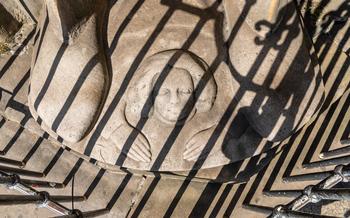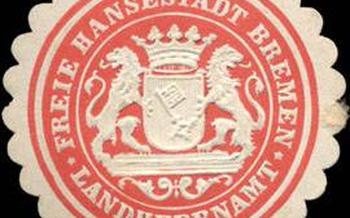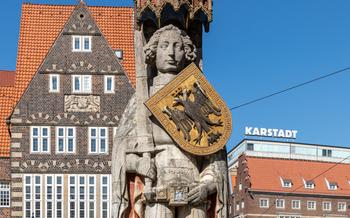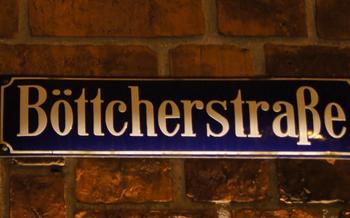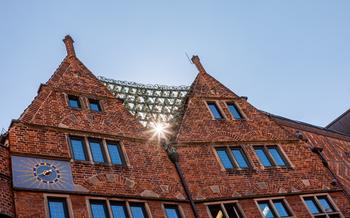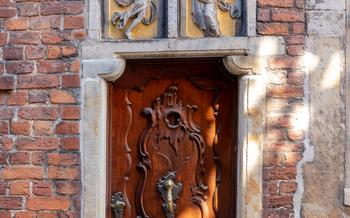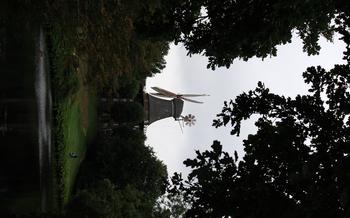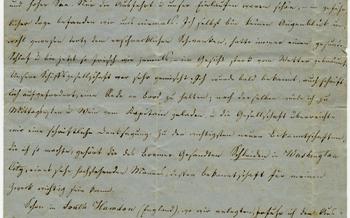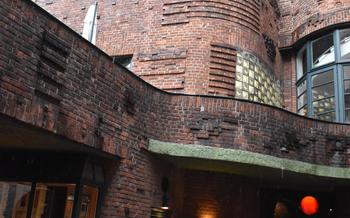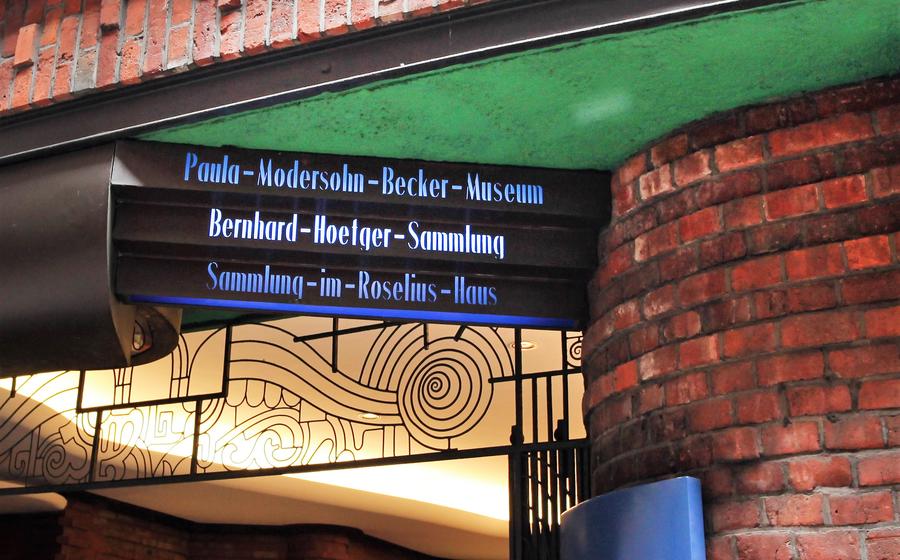
Kunstsammlungen Böttcherstraße
- A Stroll in Bremen’s Historic District
- Kunstsammlungen Böttcherstraße: An Artistic Haven
- The Paula Modersohn-Becker Museum: A Female Pioneer's Legacy
- The Roselius Haus: A Merchant's Vision
- The Glockenspiel: A Melodious Masterpiece
- The Böttcherstraße Ensemble: A Harmony of Architecture and Art
- The Worpswede Artists' Colony: A Creative Haven
- The Café Haus Atlantis: A Culinary and Cultural Experience
- The Böttcherstraße Museum: Delving into the District's History
- The St. Petri Cathedral: A Gothic Masterpiece
- The Bremen Town Musicians: A Beloved Fairy Tale
- The Schnoorviertel: A Quaint Historic Neighborhood
- The Bremen Market Square: A Bustling Hub of Activity
- Insider Tip: Explore the Böttcherstraße at Night
A Stroll in Bremen’s Historic District
Stroll along the cobblestone streets of Bremen's historic district, a UNESCO World Heritage Site, and immerse yourself in its rich architectural heritage. Admire the blend of Gothic, Renaissance, and Baroque styles, as you explore the charming old town. Discover hidden gems and intriguing stories while wandering through these historic streets, where every corner holds a new surprise. Let the beauty of Bremen's Altstadt transport you back in time and experience the charm of this Hanseatic city.
Kunstsammlungen Böttcherstraße: An Artistic Haven
Nestled within the heart of Bremen's historic Böttcherstraße district, the Kunstsammlungen Böttcherstraße stands as a testament to the city's rich artistic heritage. This renowned art museum offers a diverse collection that spans centuries, inviting visitors on a captivating journey through the world of art.
Established by Ludwig Roselius, a prominent coffee merchant and art collector, the Kunstsammlungen Böttcherstraße opened its doors in 192Housed in a series of beautifully restored historic buildings, the museum seamlessly blends art and architecture, creating a unique and immersive experience for visitors.
The museum's collection encompasses a wide range of artistic styles and mediums, from medieval masterpieces to contemporary creations. Visitors can admire works by renowned artists such as Paula Modersohn-Becker, Emil Nolde, and Max Beckmann, alongside lesser-known gems that offer a glimpse into the diversity of German art history.
Whether you are an art enthusiast or simply looking to appreciate the beauty of artistic expression, the Kunstsammlungen Böttcherstraße promises an enriching experience that will leave a lasting impression.
The Paula Modersohn-Becker Museum: A Female Pioneer's Legacy
The Paula Modersohn-Becker Museum, located within the Böttcherstraße ensemble, pays homage to the life and work of Paula Modersohn-Becker, a groundbreaking female artist who left an indelible mark on the art world. Born in Dresden in 1876, Modersohn-Becker defied societal expectations and pursued her passion for painting, becoming a pioneer in the early 20th-century art scene.
The museum, housed in a charming 16th-century building, offers a comprehensive collection of Modersohn-Becker's works, spanning her artistic journey from early Impressionist landscapes to her distinctive Expressionist style. Visitors can trace the evolution of her artistic voice as they explore the museum's galleries, which showcase her bold use of color, emotional intensity, and innovative techniques.
Modersohn-Becker's unique style, characterized by its raw emotional power and introspective nature, set her apart from her contemporaries. Her works often depicted the female form, exploring themes of motherhood, identity, and the human condition. She was also deeply influenced by the Worpswede Artists' Colony, where she found inspiration in the natural surroundings and the close-knit community of artists.
The Paula Modersohn-Becker Museum celebrates the artist's groundbreaking contributions to the art world, showcasing her as a trailblazer who challenged conventions and paved the way for future generations of female artists. Her legacy continues to inspire and captivate audiences, making the museum a must-visit for anyone interested in art history and the life of this extraordinary artist.
The Roselius Haus: A Merchant's Vision
Ludwig Roselius, a prominent coffee merchant and art collector, played a pivotal role in the creation of the Böttcherstraße ensemble. In 1902, he purchased a modest house on the street and commissioned the renowned architect Bernhard Hoetger to transform it into a stunning example of Art Nouveau architecture. The resulting structure, known as the Roselius Haus, is a testament to Roselius's vision and passion for the arts.
The Roselius Haus is distinguished by its intricate façade, featuring colorful ceramic tiles, sculptural reliefs, and stained glass windows. The interior is equally impressive, with elegant rooms adorned with Art Nouveau furnishings, paintings, and sculptures. The building became a symbol of Roselius's success and a gathering place for artists, intellectuals, and cultural enthusiasts.
Roselius's legacy extends beyond the Roselius Haus. He was a generous patron of the arts and supported numerous cultural initiatives in Bremen. His vision for the Böttcherstraße as a vibrant artistic hub helped to transform the street into one of the city's most iconic landmarks.
The Glockenspiel: A Melodious Masterpiece
Amidst the architectural marvels of the Böttcherstraße, the Glockenspiel stands out as a charming mechanical musical instrument that captivates visitors with its melodious tunes. Intricately crafted with 30 bells, this masterpiece of horology comes alive at scheduled intervals, filling the air with enchanting melodies. Its repertoire includes traditional German folk songs and classical pieces, adding a touch of musical magic to the already captivating atmosphere of the Böttcherstraße.
Positioned prominently on the façade of the Haus des Glockenspiels, the Glockenspiel draws crowds of onlookers who gather to witness its mesmerizing performance. As the bells chime and dance in perfect harmony, the melodies transport listeners to a bygone era, creating a truly unforgettable experience. Whether you're a music enthusiast or simply seeking a moment of tranquility amidst the bustling city, the Glockenspiel offers a delightful auditory treat that will leave you spellbound.
The Böttcherstraße Ensemble: A Harmony of Architecture and Art
The Böttcherstraße ensemble is a remarkable architectural masterpiece that seamlessly blends various styles, creating a cohesive and harmonious streetscape. Renowned architects, including Rudolf Alexander Schröder, Bernhard Hoetger, and Fritz Höger, collaborated to design the buildings, each contributing their unique artistic vision.
Expressionism, Art Nouveau, and Renaissance Revival styles converge in the Böttcherstraße, resulting in a dynamic and visually captivating architectural landscape. The buildings feature intricate facades adorned with sculptures, reliefs, and colorful tiles, showcasing the artists' creativity and attention to detail.
The Böttcherstraße is widely regarded as a Gesamtkunstwerk, a total work of art, where architecture, sculpture, and painting converge to create a unified and immersive aesthetic experience. This concept, popular in early 20th-century Germany, sought to merge different art forms to achieve a holistic artistic expression.
The Böttcherstraße ensemble stands as a testament to the collaborative spirit and artistic vision of its creators. It is a living example of how architecture and art can harmoniously coexist, creating a vibrant and inspiring urban space.
The Worpswede Artists' Colony: A Creative Haven
In the heart of the picturesque countryside surrounding Bremen, the Worpswede Artists' Colony emerged as a haven for creativity and artistic expression. Founded in the late 19th century, the colony attracted a group of talented painters who sought inspiration in the idyllic landscapes and the simple life of the region.
Among the most prominent members of the Worpswede colony were Fritz Mackensen, Otto Modersohn, Hans am Ende, and Heinrich Vogeler. Their works captured the essence of the Worpswede landscape, with its vast moors, tranquil rivers, and ancient forests. They also depicted the daily lives and traditions of the local people, celebrating the harmony between nature and human existence.
The Worpswede artists' style was characterized by a deep emotional connection to the land, a commitment to realism, and a desire to convey the spiritual essence of the natural world. Their paintings exuded a sense of peace and serenity, reflecting the tranquility of the Worpswede surroundings.
The Worpswede Artists' Colony played a pivotal role in the development of German art history. It marked a departure from the prevailing academic and historical styles, paving the way for the emergence of Expressionism and other modern art movements. The legacy of the Worpswede artists continues to inspire contemporary artists and art enthusiasts alike, solidifying their place in the annals of German art.
The Café Haus Atlantis: A Culinary and Cultural Experience
Nestled within the heart of the Böttcherstraße, the Café Haus Atlantis invites visitors to embark on a journey of culinary delight and cultural immersion. Step into its Art Nouveau wonderland, where intricate stained-glass windows, elegant chandeliers, and elaborate wall paintings create an atmosphere of timeless charm.
Indulge in a tantalizing menu that pays homage to traditional German cuisine, showcasing regional specialties and hearty dishes prepared with fresh, local ingredients. Savor the flavors of the Bremer Knipp, a savory sausage and potato dish, or the Bremer Labskaus, a hearty sailor's stew. Pair your meal with a refreshing German beer or a selection from their extensive wine list.
Beyond its culinary offerings, the Café Haus Atlantis is a vibrant cultural hub. Regular exhibitions showcase the works of local artists, while live music performances and literary readings fill the air with creativity and inspiration. Sink into the plush velvet seats, sip on a warm beverage, and let the artistic spirit of the Böttcherstraße wash over you.
Whether you're seeking a leisurely lunch break, an intimate dinner date, or a cozy spot to soak in the ambiance, the Café Haus Atlantis promises an unforgettable experience. As you savor the flavors of traditional German cuisine amidst the stunning Art Nouveau decor, you'll feel transported to a bygone era where art, culture, and culinary delights intertwine.
The Böttcherstraße Museum: Delving into the District's History
Nestled within the heart of the Böttcherstraße ensemble, the Böttcherstraße Museum invites visitors on a journey through time, exploring the rich history and transformation of this remarkable district. Through a captivating collection of artifacts, photographs, and documents, the museum unveils the stories behind the buildings, personalities, and events that shaped the Böttcherstraße into the vibrant cultural hub it is today.
As you step into the museum, you'll be greeted by knowledgeable guides and interactive exhibits that bring the district's past to life. Learn about the visionary architects and artists who collaborated to create this unique ensemble, blending Expressionist, Art Nouveau, and Renaissance Revival styles. Discover the fascinating stories of the merchants, artisans, and residents who played a role in the Böttcherstraße's development.
Explore the museum's exhibits to gain insights into the district's maritime heritage, its role as a center of commerce and trade, and its transformation during the 20th century. Admire historic photographs that capture the Böttcherstraße in different eras, showcasing its architectural evolution and the lives of its inhabitants. Through the museum's collection, you'll gain a deeper appreciation for the history and significance of this extraordinary district.
The St. Petri Cathedral: A Gothic Masterpiece
Towering over the historic heart of Bremen, the St. Petri Cathedral stands as a testament to the city's rich architectural heritage and religious significance. Constructed between the 11th and 15th centuries, this magnificent Gothic edifice boasts an impressive array of architectural features that have earned it widespread acclaim.
Adorned with intricate carvings, soaring spires, and graceful buttresses, the St. Petri Cathedral exudes an aura of grandeur and spirituality. Its imposing façade is a symphony of Gothic artistry, with pointed arches, ribbed vaults, and delicate tracery creating a harmonious ensemble. The cathedral's interior is equally awe-inspiring, with its vast nave, lofty columns, and stained-glass windows casting a warm and ethereal glow.
Throughout its storied history, the St. Petri Cathedral has played a pivotal role in Bremen's religious and cultural life. It served as the seat of the Archbishop of Bremen, a powerful ecclesiastical figure who wielded significant influence in the region. The cathedral also witnessed numerous important events, including coronations, weddings, and religious festivals.
Today, the St. Petri Cathedral remains a vibrant and active place of worship, drawing worshippers and visitors alike. Its regular services, concerts, and exhibitions offer a glimpse into the rich spiritual and cultural traditions that have shaped Bremen's identity. Whether admiring its architectural splendor, exploring its historical significance, or simply seeking a moment of tranquility, the St. Petri Cathedral is an essential destination for anyone visiting Bremen.
The Bremen Town Musicians: A Beloved Fairy Tale
In the heart of Bremen, a charming bronze statue captures the essence of a beloved fairy tale known worldwide—the Bremen Town Musicians. This enchanting sculpture, created by Gerhard Marcks in 1953, depicts the four animal protagonists of the Brothers Grimm story: a donkey, a dog, a cat, and a rooster. United by their shared desire for freedom and adventure, these unlikely companions embark on a journey to the city of Bremen to become town musicians.
The statue, located in the bustling market square, has become an iconic symbol of Bremen, attracting visitors from around the world. Its whimsical charm and heartwarming narrative have captivated generations, inspiring countless adaptations and interpretations of the fairy tale. The statue serves as a reminder of the power of friendship, courage, and perseverance, reminding us that even the smallest creatures can achieve great things when they work together.
Touching the animals' noses or hooves is said to bring good luck, and many visitors participate in this tradition, adding to the statue's allure. Whether you're a lifelong fan of the fairy tale or simply captivated by its charm, the Bremen Town Musicians statue is a must-see attraction, offering a unique blend of history, art, and folklore in the heart of this vibrant city.
The Schnoorviertel: A Quaint Historic Neighborhood
Adjacent to the Böttcherstraße lies the Schnoorviertel, a charming historic neighborhood that transports visitors back in time. Its narrow cobblestone streets, lined with colorful houses, create a picturesque setting that exudes a unique charm. The Schnoorviertel has a rich maritime history, having once been home to sailors, fishermen, and artisans who played a vital role in Bremen's development.
Strolling through the Schnoorviertel is like stepping into a living museum. The neighborhood's well-preserved buildings showcase various architectural styles, from medieval to Renaissance, reflecting its long and diverse history. Visitors can explore its many unique shops, boutiques, and galleries, offering everything from handmade crafts to antiques and souvenirs.
The Schnoorviertel is also known for its vibrant atmosphere, with inviting cafés, restaurants, and bars lining its streets. Whether seeking a traditional German meal, a cozy coffee break, or a lively evening out, the Schnoorviertel has something to offer everyone. Its charming ambiance and friendly locals make it a popular destination for both tourists and locals alike.
The Bremen Market Square: A Bustling Hub of Activity
The Bremen Market Square, the vibrant heart of the city's historic center, pulsates with life and energy. A lively tapestry of market stalls, street performers, and outdoor cafés creates a captivating atmosphere that draws locals and visitors alike. The square's architectural highlights, including the majestic Rathaus (Town Hall) and the Schütting (Merchants' Hall), stand as testaments to Bremen's rich history and architectural prowess. The Rathaus, with its ornate Gothic façade and intricate carvings, is a masterpiece of medieval architecture. The Schütting, with its Renaissance-style grandeur, reflects the city's prosperity during the Hanseatic League era. The Bremen Market Square is not just a place of commerce but also a gathering place for celebrations, events, and festivals. Throughout the year, the square transforms into a lively venue for concerts, markets, and cultural events, showcasing Bremen's vibrant spirit and rich traditions.
Insider Tip: Explore the Böttcherstraße at Night
For an enchanting experience, visit the Böttcherstraße after dark. The illuminated buildings and streetlights create a magical ambiance, transforming the district into a captivating scene. Take a leisurely stroll to appreciate the architectural details and sculptures, which are even more striking under the soft glow of the night lights. Capture stunning photographs of the Böttcherstraße after dark, showcasing its unique beauty and charm. This nocturnal exploration offers a different perspective on this historic district, allowing you to immerse yourself in its charm and tranquility.
